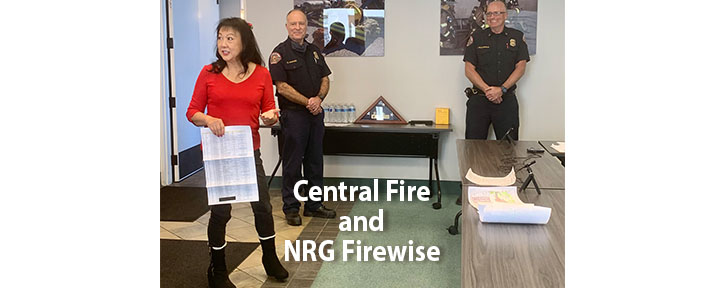
Central Fire District honored the NRG Firewise community for our progress on preventative fire programs. When these organizations work together to educate, support, and guide one another, we really do get things done! The Central Fire team has come to road association meetings, Firewise planning sessions, and even worked with individual homeowners to help us prioritize home hardening and clearing around our houses. Looking forward to our April 23, 2022 NRG Firewise event! We’ll have over a dozen experts speak about all of the issues we’re concerned about — and Central Fire will be instrumental at this event.

Central Fire District honored the NRG Firewise community for our progress on preventative fire programs. When these organizations work together to educate, support, and guide one another, we really do get things done! The Central Fire team has come to road association meetings, Firewise planning sessions, and even worked with individual homeowners to help us prioritize home hardening and clearing around our houses. Looking forward to our April 23, 2022 NRG Firewise event! We’ll have over a dozen experts speak about all of the issues we’re concerned about — and Central Fire will be instrumental at this event.

Ten years ago, I never really thought much about wildfires – even though I live in a heavily wooded area in Santa Cruz County. But now, I make architectural, landscaping, and even social decisions based on how they affect fire safety. That’s why I’m thrilled that my neighborhood of 260 homes on North Rodeo Gulch Road in Soquel is now officially recognized as a Firewise USA community.
What does that mean?
- Save money on homeowner’s insurance
- Work with neighbors to clear our properties
- Share concerns on our forum
- Receive free chipping
- Communicate using our MURS radios during emergencies
- Improve address and road signage
- Gather for annual NRG Firewise events
I’m organizing our 2nd annual event on April 23rd with a lineup of experts who will discuss evacuation plans, emergency communications (when power is out), clearing 100 feet around homes, group clearing projects, signage, and more. Come out to learn when to evacuate and how you can save your home when a wildfire strikes. Fire season is year round.
Check out our website: NRGfirewise.com.
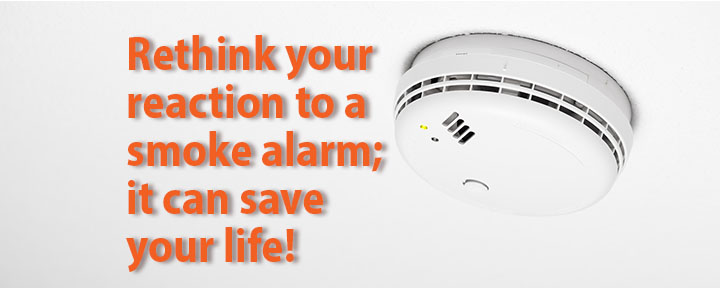
With all the news about wildfires destroying millions of acres each year, I’ve been hyper focused on how to handle evacuations and grabbing my go bag. I haven’t thought about what to do if I had a fire inside the house. That’s why when my smoke detector went off in the hallway yesterday, I immediately grabbed a stool to silence it. After all, for the past 40 years, my only interaction with my smoke detector was replacing the battery when it would beep or pulling the batteries out when I accidentally burnt garlic bread in my oven causing smoke to set it off.
But this time, I actually did have a fire inside my house.
When the first smoke alarm screeched an annoying siren, I pressed the button to disarm it. But it kept beeping. So I pulled the batteries out, but oddly, it kept beeping. Then 4 other smoke alarms went off in different parts of the house; the noise was loud. The dogs started to howl while Rob, my husband, and I were racing around trying to disarm the alarms.
We didn’t think there was a fire because we didn’t see any smoke and didn’t smell a fire.
We did smell an unusual odor (not the familiar wood fire) and began to see light gray smoke near the ceiling. Rob followed the smoke into the gift wrap room where he saw flames creeping up the wall from the carpet. He grabbed satin cloth and put out the fire.
One of the batteries in a headlamp charger exploded causing small embers to spray across the carpet. It probably smoldered there for a few minutes before igniting. We were lucky that we caught it before it caught the wrapping paper on fire.
When I told Nicole, my oldest daughter, about the series of events, she was quick to say, “Everything you did was absolutely wrong!” And she was right. She asked why we were so intent on stopping the sound instead of looking for the possible fire.
I had become so accustomed to dealing with annoying batteries in smoke alarms and airing out the house when my garlic bread burnt. I learned how to disarm the smoke detector because I never believed that I would actually have a fire in my house. I forgot to first check the scene to see if it was safe.
I’m sharing this story with you so you don’t make the same mistake I did. When your smoke detector goes off, first assess the situation to make sure that there is no fire before pushing that silence button. The sooner you find the fire, the less damage it will cause. I learned this the hard way.
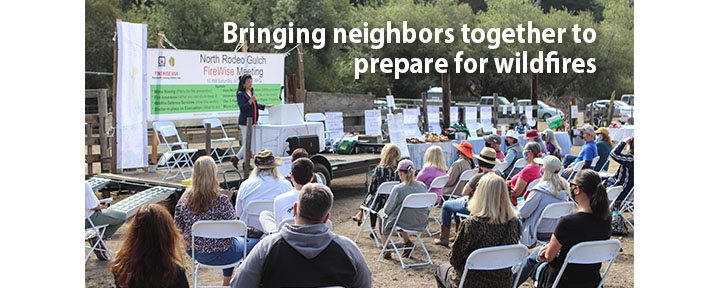
Living in a tinderbox in one of the most beautiful places on earth causes one to wonder if I’m crazy for living on 2-acres at the base of the Santa Cruz Mountains. Rather than run (to where?), I’ve made it my mission to make my neighborhood of almost 200 homes more fire safe by organizing and applying to become a Firewise USA recognized community.
I hosted a well-attended event with over 15 speakers to discuss clever and innovative ways that we can mitigate wildfire. Supervisor Manu Koenig spoke about what he’s doing to improve our roads and support Firewise neighbors. Central Fire Deputy Marshal Marco Mack discussed his proposal to get reflective address and road signs up so EMS and firefighters can find us and why everyone should sign up for CODE-Red, and Tony Akin, Central Fire, shared tips on home hardening, evacuation, and sheltering in place.
Then we had experts talk about using ham and MURS radio communication when our power goes out. Others talked about CERT, Go Bags, and limbing up and trimming trees. Having these enthusiastic members of nonprofit organizations sharing their tips and encouraging our neighbors to get involved created a powerful message: We can do something to reduce our fire risk.
My community wanted to know about fire-retardant paint and other products so I invited vendors to talk about the best vents (Vulcan Vents), paints (Firefree), services (Safer Building Solutions), and fire insurance and Wildfire Defense Systems (State Farm). Guests talked to these vendors about their individual concerns for hours after the event.
I invited 2 of my students to share their solutions for keeping their homes safe. Arul Mathur introduced F.A.C.E. (Fire Activated Canister Extinguisher) and Anush Anand discussed how vinyl gutters and siding are flammable.
Check out the video to learn more.
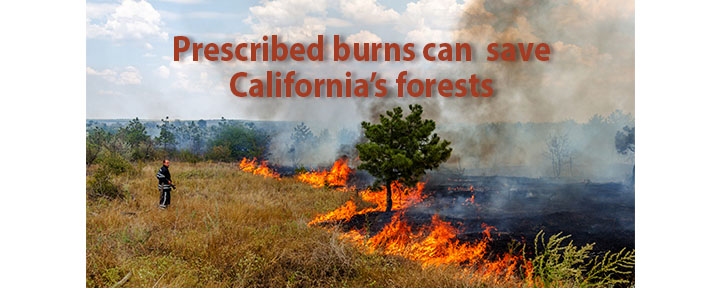
After losing over 4 million acres of forests last year to wildfires in California – that’s 1/10th of our total forestland – we need to take a proactive approach to save the remaining 33 million acres. Native Americans have been doing prescribed burns for centuries, and now Cal Fire and the Federal Forest Service are planning to do just that.
The goal is to reduce fire risk on 1 million acres of forest and wildlands each year. They’ll do this by manually thinning overgrown forests and intentionally burning hundreds of thousands of acres annually. The federal government will handle the lion’s share of the forestland, while Cal Fire works with private landowners through the vegetation management program.
For the past 100 years, California has focused on suppressing all prescribed fires, and now we’re paying a huge price for that. Even though some residents oppose these burns due to increased air pollution, we need to reduce the possibilities of having more out-of-control wildland fires. I think we all can deal with a few smoky days while we create firebreaks and manage our forests so we don’t lose our homes, lives, and remaining forests.
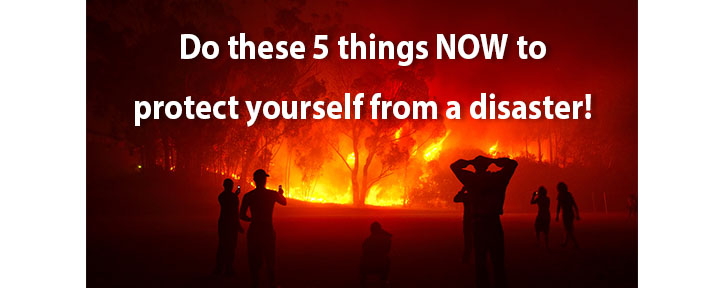
Here we are again in the middle of a perfect storm: Fires are raging in California after Sunday’s lightning thunderstorms that sparked fires amidst some of the hottest days we’ve had on record. This is unnerving as we’re already dealing with fears of COVID-19, loss of jobs, displaced students, and isolation from friends. This is the best time to fill out my Micro-Community Disaster Plan and Information packet to prepare your family now. Here are 5 proactive things you can do now to give you more control over the many things that feel completely out of our control today.
#1: REACH OUT TO YOUR NEIGHBORS
Put your differences aside, and email or visit with your neighbors today. Check in with them to update their contact information so you can help if they need support in evacuating or taking care of pets if they’re not at home.
#2: CREATE A FAMILY DISASTER PLAN
Select a meeting place to avoid going in circles searching for one another should there be an evacuation or a disaster. Make sure all family members understand that they should meet at this location and wait for everyone to arrive. Choose an out-of-state (or out-of-area) person to be the contact person. That way, if cell phones aren’t working or your internet is down, your contact person can retrieve messages and keep everyone informed of the status of each family member.
* Disaster Plan
#3: MAKE YOUR GO-BAGS
Gather the things you absolutely need to survive, and place them in a backpack or suitcase. Think: medications, personal items, clothing, water, food. Be prepared as evacuation orders don’t give you much time. If evacuation isn’t eminent, then create a Go Bag for your car and your house so you’ll always be ready.
#4: SIGN UP FOR CODE RED
Go to your alert notification systems and sign up for alerts. That way, you’ll be alerted to evacuation orders and you can start preparing by gathering your family, pets, and Go Bags. You can also help your neighbors by giving them a heads up and helping those who are non-ambulatory.
#5: PROTECT YOUR HOUSE
Move wooden or flammable items that are within 5 feet of your house. That means that cord of wood next to the garage, wooden picnic tables, old planter boxes, and other things. Ideally, move them 100 feet from your house but do whatever works for your home and property.
If time permits, remove dead branches and lower limbs on trees that are within 100 feet of your house. This could reduce the chance the wildfires would make their way to your homes. Weedwhack dense areas to create a firebreak. Clean out gutters and debris that have collected on your roofs. Learn more here.
Whether you’re waiting for evacuation orders or you just haven’t had time to prepare for disasters, let this be a wake-up call to get started. Share this with family and friends, and encourage them to do prepare now.
